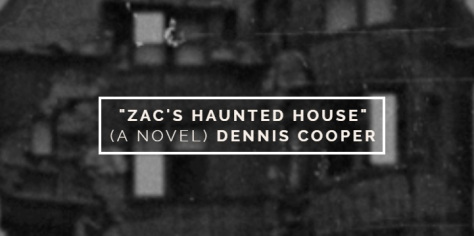To open this film blog I am beginning with a first on two levels. This is not only this first post on the Projection Wall film blog but also the first in a series on women directed films and how they fit into a canon built primarily on the works of men. I begin with one of the key aspects of film studies, genre, and examine how each of these filmmakers use male established generic conventions as point zero in films that ultimately tell female stories.
A Girl Walks Home Alone At Night (2014) dir.Ana-Lily AmirpourAna- Lily Amirpour, having worked in both the Iranian and American industry draws on a variety of cinematic styles and movements in the creation of a singular vision in her debut feature, A Girl Walks Home Alone at Night (2014). It is, as she describes it, an “Iranian Vampire Spaghetti Western”, that draws from the Italian-American westerns of Sergio Leone as well as the early vampire films of the German expressionists, all through an Iranian lens. The use of the ghost- town “Bad City” as the setting fits the nowhere feeling that the blending of world cinema styles lays which all work to further break down the walls that film critics argue first began to fall along with the Berlin wall in the destruction of notions of national cinema and the growth of a global market. The release of this film 2 years after the final film of the hugely successful American film franchise The Twilight Saga, which grossed a combined $1.5 billion over its 5 films, also reads in how Amirpour addresses the problematic framing of women in American cinema as passive. Twilight’s main character, Bella, and the predatory human-vampire romance that it presents is contradicted in every step of the relationship between The Girl (played by Sheila Vand) and Arash (Arash Marandi) whose lives are established independently before coming together in one of the most emotive and memorable scenes in the film. The scene (watch here) shows the two with Arash dressed as a vampire, however his injured arm displays visually the inversion of the dominance of the males in these popular supernatural romances, coming to a head as the power is given fully to the vampiric young woman, dressed plainly and unthreateningly, as she tilts his head back to reveal his bare neck. Amirpour establishes the setting before moving to frame just the two figures and shows the room filled with images of American icons such as the Bee-Gees and Madonna, placing an emphasis on the prominence of American media. The inclusion of Amirpour’s own image (overlapping the bottom left corner of the Michael Jackson poster) on this mural of American icons places her among these influential stars of American culture making clear her revisionist look at popular American media and equating herself with them.
.
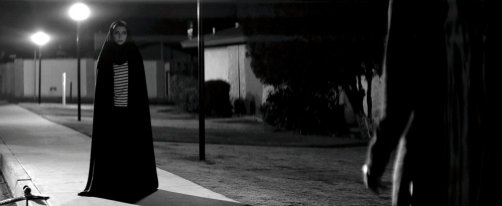 Western standoff framing in Amirpour’s A Girl Walks Home Alone at Night (2014) along with the classic Hollywood black and white pallet.
Western standoff framing in Amirpour’s A Girl Walks Home Alone at Night (2014) along with the classic Hollywood black and white pallet.
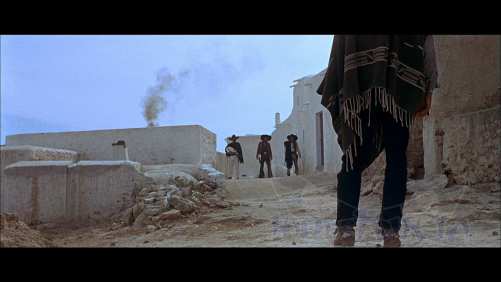 Clint Eastwood as Man with No Name with classic Spaghetti Western framing in Leone’s For a Few Dollars More (1965).
Clint Eastwood as Man with No Name with classic Spaghetti Western framing in Leone’s For a Few Dollars More (1965).
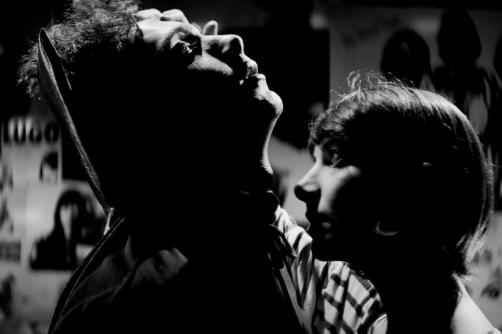 Amirpour films the faux attack with stark contrasts in light to create harsh shadows on the figures
Amirpour films the faux attack with stark contrasts in light to create harsh shadows on the figures
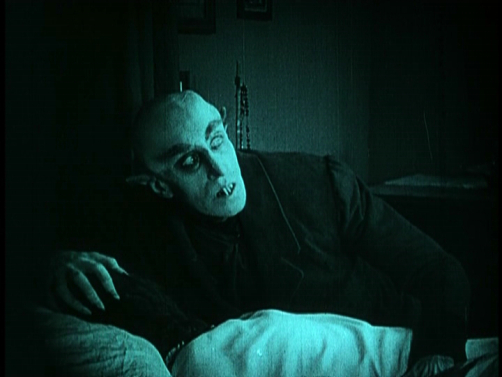 F. W. Murnau’s Nosferatu (1922), considered the first vampire film and a staple of the German Expressionism movement in early cinema, typified by its use of shadow and light.
Wonder Woman (2017) dir.Patty Jenkins
F. W. Murnau’s Nosferatu (1922), considered the first vampire film and a staple of the German Expressionism movement in early cinema, typified by its use of shadow and light.
Wonder Woman (2017) dir.Patty Jenkins
Jenkins shaped the expectation of women in Hollywood both in front of and behind the camera in her debut feature Monster (2002) in how she depicts Charlize Theron in the role of Aileen Wuornos and followed up on the opposite end of the moralistic scale with Wonder Woman (2017). While Ana-Lily Amirpour’s film responded to the generic and national conventions of classic cinemas from around the world, Wonder Woman deals very much with the contemporary conventions of blockbuster American cinema, which has undoubtedly dominated by Superhero films since Jon Favreau’s Iron Man in 2008. The outcry since the release of the first Avengers movie in 2012 for a Scarlett Widow lead film and the disappointment at the lack of merchandise for the only non-male member of the superhero team has shown the interest in a film that gave centre screen to a superheroine. Despite this, now 10 years on since the beginning of the Marvel Cinematic Universe, only this year with Ant-Man and the Wasp will we see a Marvel movie with a lady’ name in the tile, and not until Captain Marvel in 2019 that a female hero will be front and centre. While Marvel remains the darling of both fans and critics, with the most recent release Thor: Ragnarok holding a 92% on Rotten Tomatoes, the less developed and less loved DC extended universe took the lead in the heroine department and placed Jenkins at the helm of the and highly anticipated first ever Wonder Woman feature film. This film could have failed at many points, but somehow came together to revitalise the tired ‘hero’s origin story’ that we’ve all seen too many times now and did so while reinventing a treasured character and instilling her with a new relevance. For me, one of the most admirable things the film avoided was the “born sexy yesterday” trope that Pop Culture Detective coined in the YouTube of the same name (watch here), he describes the frequent appearance of women who are in some way socially naïve and inexperienced, which is then problematised when the film sexualises that character, and specifically that aspect of the character. While the movement of the sheltered Diana from her safe home in Themyscira to World War 1 Europe makes for some inevitable “fish out of water” beats, this at no point is a sexualised part of her character. In fact, her upbringing often works to their advantage as she is fluent in all languages and knows about military strategies, and her moments of misunderstanding function more as a disagreement at the decisions being made by the men than a moment to point to her as being wrong providing her with added agency and drive throughout the movie. The success of this first female-led superhero movie should render mute the oft-used excuse that they are less marketable or dependable for the investors as this film grossed 8 times its budget and matched the rotten tomatoes score of Thor: Ragnarok with 92%
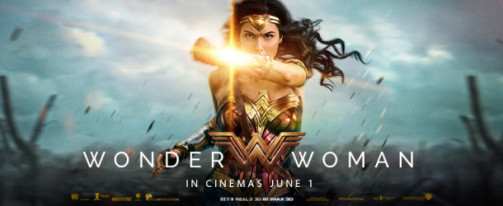 The poster of the film emphasises action and the functionality of her outfit that may have otherwise been used as a tool to sexualize her.
The poster of the film emphasises action and the functionality of her outfit that may have otherwise been used as a tool to sexualize her.
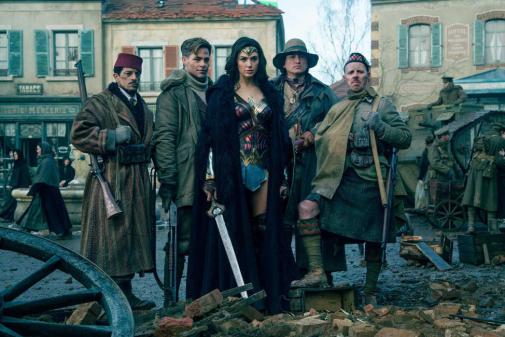 The picture which acts as the catalyst that frames the film and represents the time Diana spent fighting in the war, which places her unmistakably as the leader of the group.
The picture which acts as the catalyst that frames the film and represents the time Diana spent fighting in the war, which places her unmistakably as the leader of the group.
A League of Their Own (1992) dir.Penny Marshall
Certainly, the most established of the filmmakers listed here, Marshall, having built her career as an actress, and proving herself as a director with Big (1988), makes one of the most iconic sports movies in A League of Their Own (1992). Following on from a decade of some of the most memorable sports movies like Raging Bull (1980), Field of Dreams (1989) and Rocky still very much in the public conscious with Rocky III (1982), VI (1985) and V (1990) coming out in the decade preceding, and baseball particularly having seen a surge of popularity with Major League (1989) and Bull Durham (1988). However, all these films give prominence to male sports and athleticism, whereas Marshall went about making a baseball film that was grounded in sport, while also celebrating women’s relationships with one another. Situating the film with the sisters Dottie (Gina Davis) and Kit (Lori Petty), and making them the entrance point and the continual focus through the early parts of the film worked to keep them central to the film and allowing to build the team around them with the teammates’ and Jimmy Dugan’s (Tom Hanks) plot lines. The film waits 30 minutes before introducing Jimmy, allowing this time to establish the women on the team and their relationships with one another, while it’s close to an hour before Jimmy is depicted as likeable to the audience. All this lends to the audiences identifying with the ladies on the team and frames them as the shining stars of the movie. The roundedness of the women on the team also marks its difference from many films that feature women in sports, resting on a tomboy stereotype, the film fleshes out the team with characters like Meg and Doris (Madonna and Rosie O Donnel) who compliment and contrast one another while being close friends. The team very much unifies against the male energy in the movie, in their disappointment at the sexualised outfits and their impatience at the etiquette lessons they’re forced to attend, emphasised when we see them in action where their physicality is brought to the forefront in the cuts, bruises and dirt they are covered in by the end of each game. Ultimately, the film reaches the same conclusions of comradery and friendship that often marks the team sports films of the late 80s and 90s, but is remarkable in how it paints the relationships of women as lasting and supportive
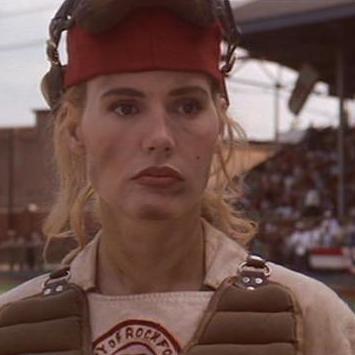 Dottie post-game covered in dirt
Dottie post-game covered in dirt
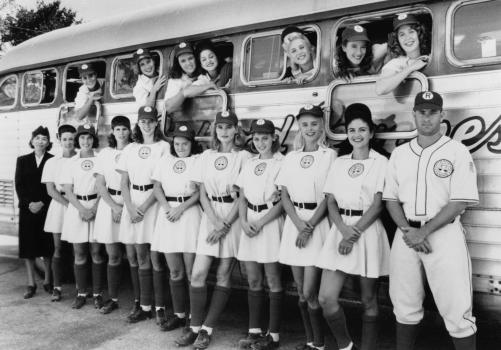 The Peaches baseball team, made up with wives, mothers, widows and single young women.
The Peaches baseball team, made up with wives, mothers, widows and single young women.
These movies all work to expand the expectations of their genre, including the same story beats and characterisations of their defining films while innovating women in film and shaking up the established norms of the male invented Hollywood cinema.
Advertisements Share this:


